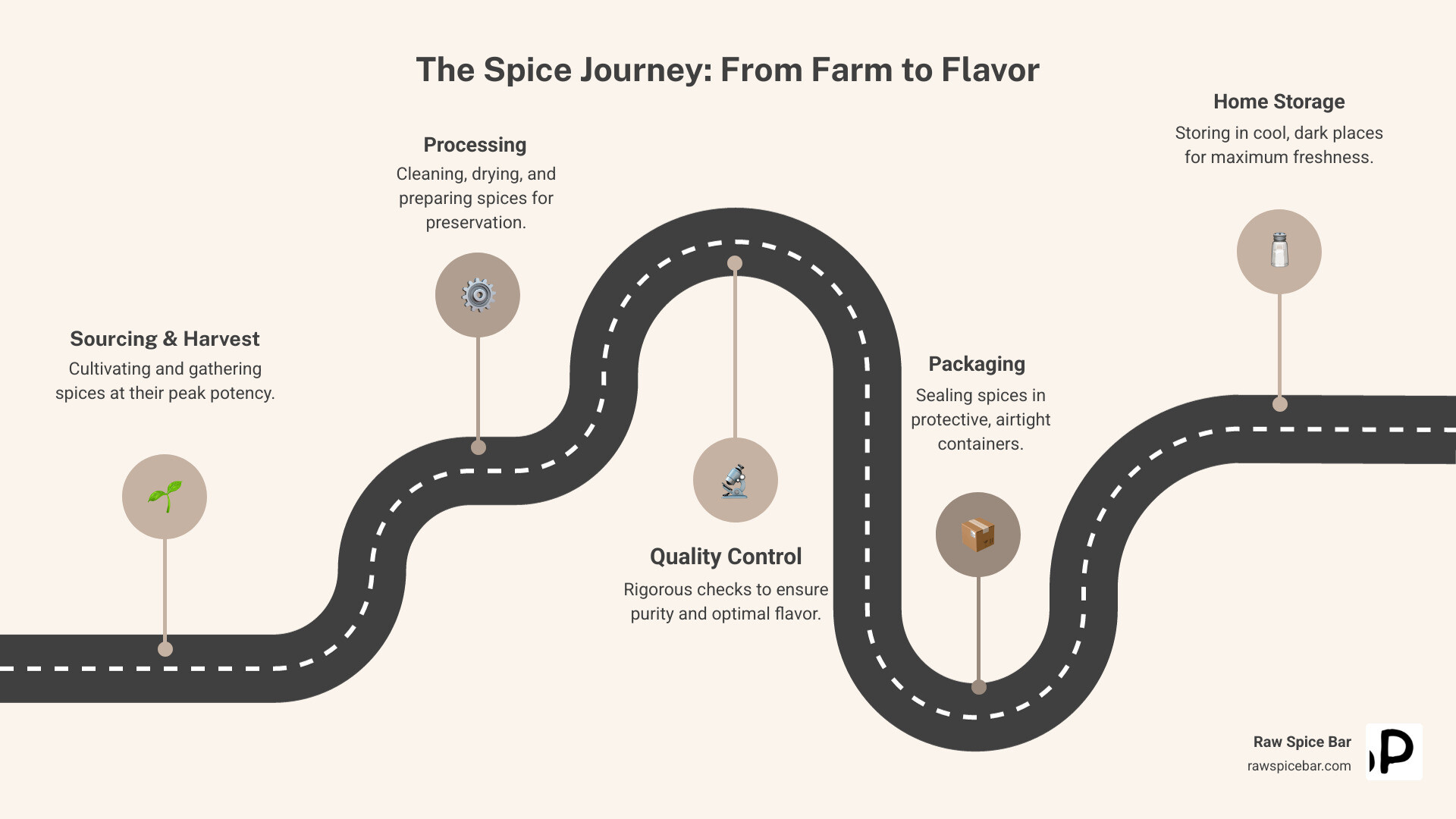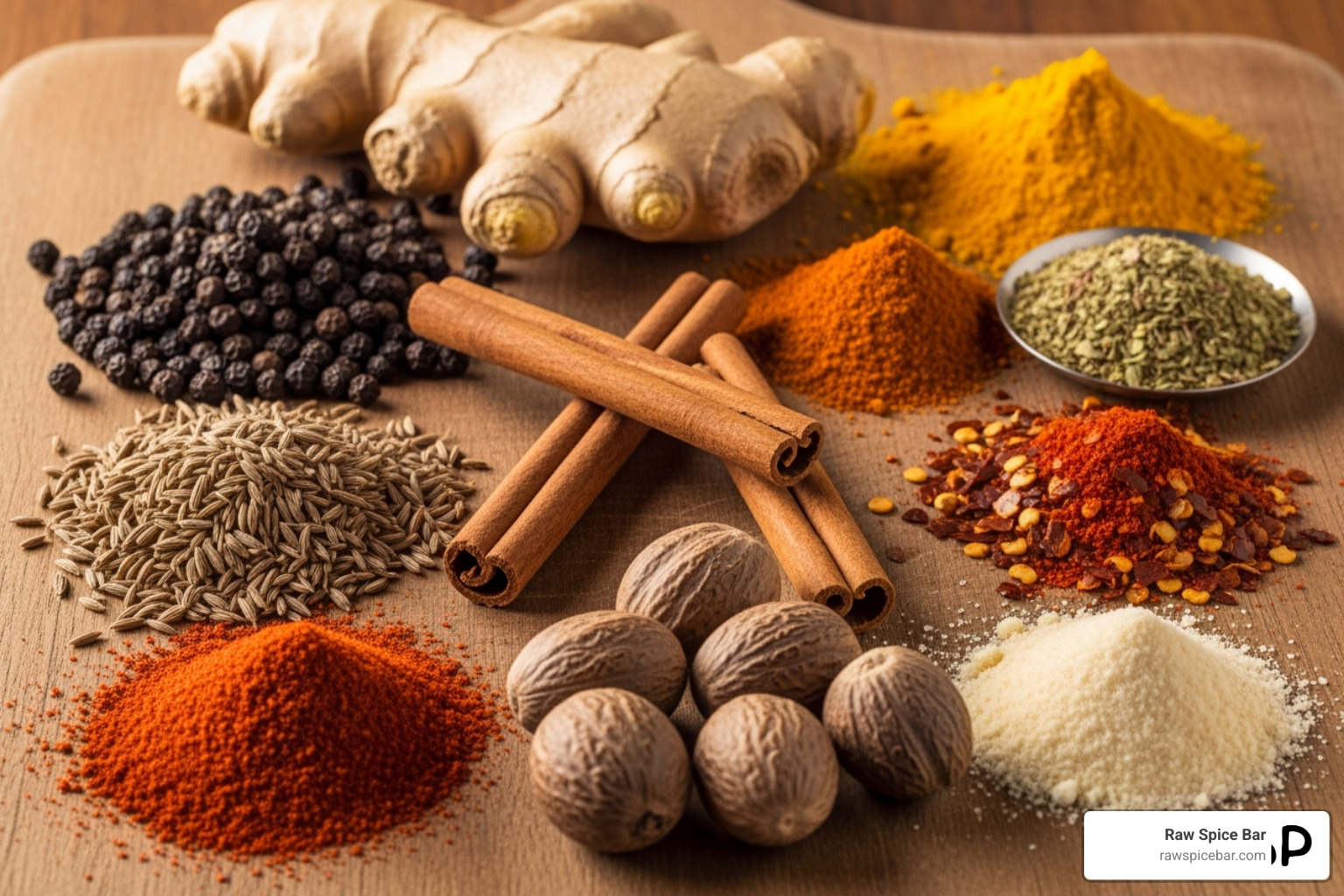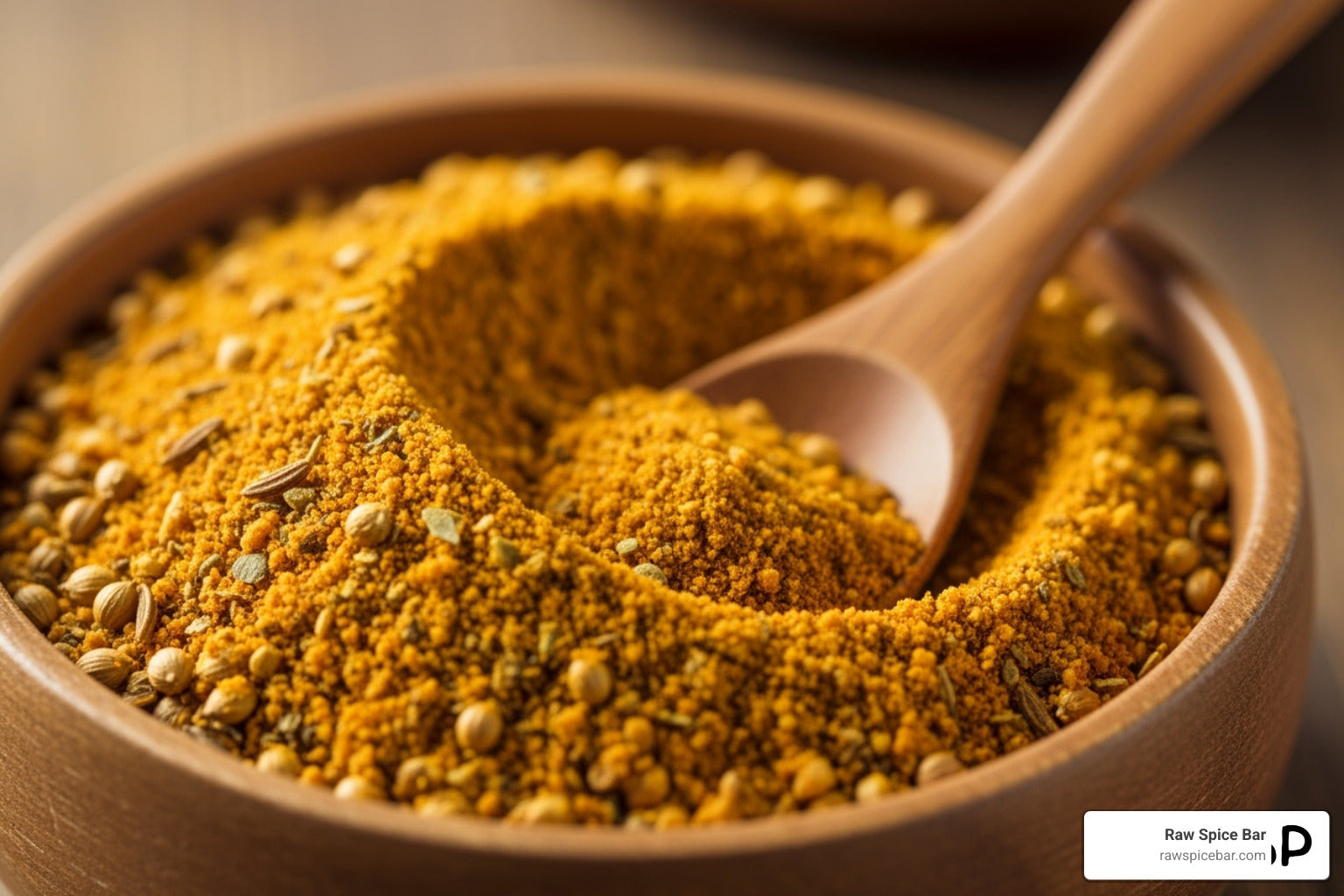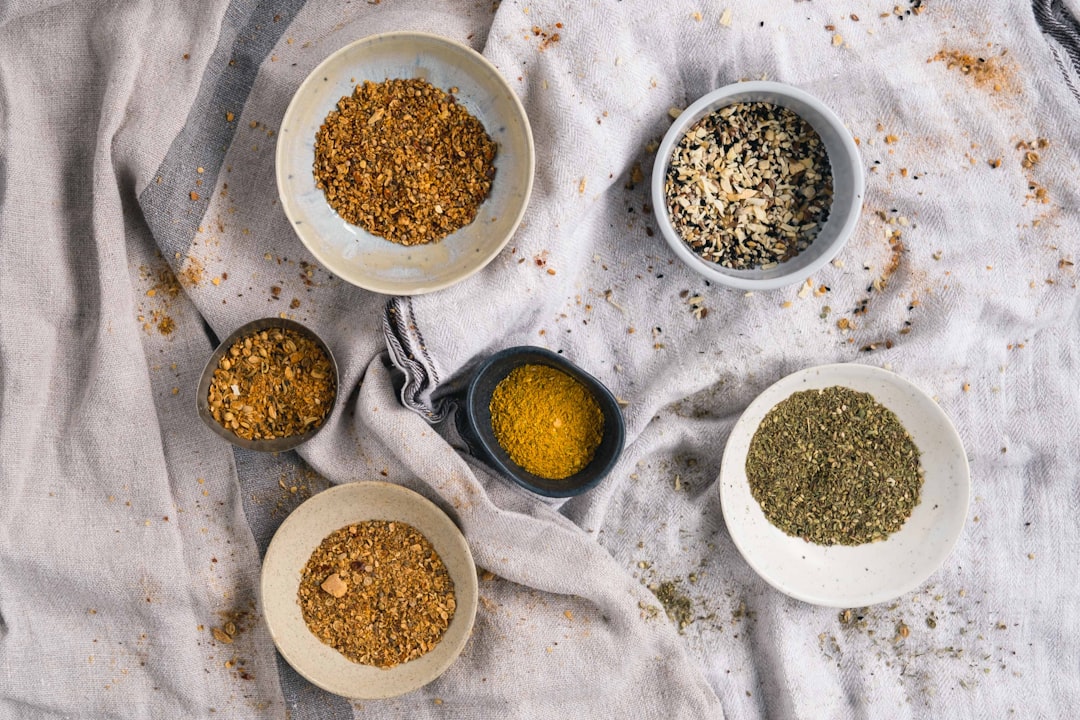Why the Best Spices Transform Every Home Kitchen
The best spices are the secret weapon that separates bland weeknight dinners from memorable meals that transport you around the world. The difference between good cooking and great cooking often comes down to spices. They don't just add flavor—they create layers of complexity that make simple ingredients sing.
As Charlemagne once said: "Spices are the friend of physicians and pride of cooks." This rings true today, as research shows that just half a teaspoon of dried oregano matches the antioxidant power of three cups of raw spinach.
Whether you're making a quick weeknight stir-fry or hosting a dinner party, the right spices can transform ordinary dishes into culinary trips. But not all spices are created equal. Ground spices lose their potency within months due to oxidation, while whole spices can maintain their flavor for up to a year. The source matters too—single-origin spices from reputable suppliers often deliver far superior flavor compared to generic supermarket blends.
I'm Joseph Rosenblatt, a food entrepreneur and founder of a spice brand. With years of experience sourcing premium spices, I've learned that having the best spices in your kitchen is the fastest way to lift your cooking and explore cuisines from around the world.

Know your best spices terms:
- good salt substitute
- herbs for healing
- salt alternative
The Essential Spice Cabinet: 10 Must-Have Spices for Every Cook

Think of your spice cabinet as a painter's palette. Just as an artist needs the right colors, you need the right spices to transform simple ingredients into amazing meals. The best spices aren't just flavor improvers—they're your ticket to exploring global cuisines from your kitchen.
Starting with versatile, foundational spices gives you incredible flexibility. These ten essentials can handle everything from a quick weeknight dinner to an elaborate weekend feast. Each brings its own personality, and together they create endless possibilities.
Our Top Picks for the Best Spices to Start With
Black peppercorns deserve the top spot. Fresh-ground black pepper is a flavor powerhouse that adds a sharp, pungent bite pre-ground pepper can't match. Try it on everything from eggs to steak.
Cumin brings earthy warmth essential in Middle Eastern and Mexican cooking. Its nutty, smoky flavor transforms simple dishes. A pinch in eggs or on roasted vegetables shows its versatility.
Paprika comes in sweet and smoky varieties. Sweet paprika adds color and mild flavor, while smoked paprika delivers rich, barbecue-like depth. Both are perfect for meat rubs, stews, and garnishes.
Cinnamon works magic in sweet and savory dishes. Famous in desserts, a tiny amount also adds warmth to chili or tomato sauce. Saigon cinnamon is particularly intense, making it one of the best spices for maximum impact.
Turmeric provides gorgeous golden color and health benefits. Its earthy, bitter taste is essential in curries, but also great in dressings, marinades, or golden milk lattes.
Dried oregano is key to authentic Italian flavor. Its bitter, aromatic flavor is perfect for pizza, pasta sauce, and roasted meats. Greek oregano is more potent, so use it sparingly.
Red pepper flakes let you control the heat. Unlike hot sauce, they add texture with spice. Adjust the amount to your taste on pizza, soups, and stir-fries.
Garlic powder provides concentrated garlic flavor without the prep. It blends smoothly into sauces, rubs, and marinades for a savory umami boost, perfect when you want flavor without the texture of fresh cloves.
Ginger adds warming spice with a slight bite. Ground ginger is convenient for baking, teas, and stir-fries. Its pain-relieving properties are great for soothing teas.
Nutmeg rounds out the list with subtle sweetness and warm aroma. A little in cream sauces or cheese dishes adds depth. It's also essential for holiday baking and drinks like eggnog.
How Spices Create Flavor
Spices work their magic through complex compounds. Understanding these flavor profiles helps you cook more intuitively.
Smoky spices like smoked paprika give dishes a grilled, campfire essence. Earthy spices such as cumin and turmeric provide grounding, rich flavors.
Sweet spices like cinnamon and nutmeg have a natural sweetness that balances savory dishes. Pungent spices like black pepper and ginger deliver a wake-up call to your taste buds.
Aromatic spices fill your kitchen with incredible scents that contribute to taste, since smell and flavor work together.
The science is fascinating. A comprehensive study on the phenolic profile of widely used culinary herbs and spices shows how these natural compounds create unique flavors and provide health benefits. Understanding how spices create flavor lets you experiment with confidence to make your dishes truly memorable.
Maximizing Potency: Whole vs. Ground Spices and Proper Storage

Nothing breaks my heart more than watching a home cook sprinkle what they think are flavorful spices onto their dish, only to taste... nothing. The best spices in the world won't help if they've lost their punch sitting in your cabinet for years.
Spices are living ingredients. They contain volatile oils that give them their amazing aromas and flavors, but these oils are delicate. The moment a spice is ground, it starts losing potency through oxidation. I've seen people hold onto the same jar of ground cinnamon for three years, wondering why their apple pie tastes flat, while whole cinnamon sticks from the same time still smell incredible when ground.
Whole vs. Ground: A Head-to-Head Comparison
Think of whole spices as nature's perfect packaging. Whole spices can stay fresh for up to four years when stored properly, while ground spices start fading after just a few months.
Convenience matters too. Ground spices are ready to go, perfect for quick dinners. Whole spices need grinding, which means extra time, but they reward you with incredible freshness and flavor intensity.
Here's when each works best: Whole spices shine in slow-cooked dishes like stews and marinades where they release flavors gradually. Ground spices excel in quick cooking like stir-fries, baking, or for an instant spice rub. The flavor release is different: whole spices are a slow burn, while ground spices hit fast and hard. Both have their place in creating the best spices experience.
How to Store Spices to Maintain Freshness
Your spices have four enemies: air, light, heat, and moisture. Protect them from these, and they'll reward you with vibrant flavors.
Airtight containers are non-negotiable. I prefer glass jars or metal tins that seal out air and light. Clear plastic containers let light slowly fade your spices' color and potency.
Keep them cool and dark. The spice rack above your stove is a flavor graveyard. Heat from cooking accelerates the breakdown of those precious volatile oils. A cool pantry or cabinet away from your stove is perfect.
Moisture is sneaky—it can cause clumping and mold. Always use a dry spoon when measuring spices, and never sprinkle directly from the container over a steaming pot.
Label everything with purchase dates. Trust me. When you open a container and don't get that immediate aroma hit, it's time to refresh your supply. The payoff for proper storage is huge: fresh spices mean you use less to get more flavor, and your dishes will taste brighter and more complex.
The Power of Spices: More Than Just Flavor
Here's something amazing: the best spices in your kitchen cabinet are basically tiny medicine chests that have been protecting human health for thousands of years. Long before modern pharmaceuticals, ancient healers in India, China, and across the Mediterranean relied on spices not just to make food taste incredible, but to treat everything from digestive issues to joint pain.
Today's science is finally catching up to what our ancestors knew all along. Those vibrant colors and intense aromas? They come from powerful compounds called antioxidants that act like bodyguards for your cells, fighting off harmful free radicals that can cause inflammation and disease.
What's truly mind-blowing is just how concentrated these health benefits are. We're talking about spices that contain up to ten times more antioxidants than many fruits and vegetables. That pinch of cinnamon in your morning coffee? It's working harder than you think.
Modern research has revealed that spices can help with everything from managing blood sugar to protecting your heart. They've been shown to have anti-cancer properties, support healthy digestion, and even help your body fight off infections. A comprehensive Antioxidant Activity of Spices and Their Impact on Human Health: A Review dives deep into the science behind these remarkable benefits.
The best part? You don't need to take supplements or make dramatic diet changes. Simply cooking with a variety of spices gives your body a daily dose of these protective compounds.
Spices with Surprising Health Perks
Let me share some of my favorite examples of how the best spices double as natural remedies:
Cinnamon is like nature's blood sugar manager. Just half a teaspoon contains as many antioxidants as half a cup of blueberries! The compound cinnamaldehyde helps your body use insulin more effectively, which is why many people with diabetes swear by adding cinnamon to their daily routine. It's also a powerful inflammation fighter that may help protect against heart disease.
Turmeric deserves its reputation as a golden healer. This bright yellow spice contains over two dozen anti-inflammatory compounds, with curcumin being the star player. Think of it as nature's ibuprofen, but without the side effects. I love adding a pinch to scrambled eggs or stirring it into warm milk for a soothing bedtime drink.
Ginger has been soothing stomachs and easing pain for centuries. Its active compounds work similarly to over-the-counter pain relievers, making it particularly helpful for arthritis and muscle soreness. Fresh ginger tea is my go-to when I'm feeling under the weather, and clinical studies back up its effectiveness for reducing inflammation.
Cloves pack an incredible antioxidant punch thanks to a compound called eugenol. These tiny flower buds are actually more potent than many synthetic antioxidants you'll find in processed foods. Beyond their warm, sweet flavor in baked goods, cloves have natural antimicrobial properties that have made them valuable in traditional medicine.
Rosemary isn't just for roasted potatoes (though it's fantastic there too). This fragrant herb contains flavonoids that research suggests may help protect against certain types of cancer. I often add a sprig to olive oil when cooking – it not only infuses beautiful flavor but actually helps prevent the oil from oxidizing.
The beautiful thing about cooking with spices is that you're nourishing your body while creating delicious meals. Every time you reach for that spice jar, you're adding both flavor and wellness to your plate.
Beyond the Basics: Exploring the World's Best Spices & Blends

Once you've built your foundation with essential spices, the real trip begins. There's a universe of extraordinary flavors waiting to transform your everyday cooking. The best spices aren't always the most common ones. Sometimes it's an exotic ingredient or a crafted blend that captures the soul of a distant cuisine. These special spices and blends are like a passport in your pantry, transporting you from Morocco to India.
Unique Spices to Try
Ready to expand your spice horizons? These single-origin spices will add new dimensions to your cooking.
Saffron is often called "red gold." This delicate spice offers a honeyed floral flavor that's magical in Spanish paella or Italian risotto. It's expensive, but a tiny pinch goes a long way, and its golden color and complex flavor are irreplaceable.
Cardamom comes in two varieties. Green cardamom has a bright, citrusy aroma that makes chai tea sing. Black cardamom brings a deep, smoky intensity to savory dishes.
Sumac is one of my favorite finds. These ruby-red ground berries add a tangy, lemony brightness that makes everything from grilled chicken to simple salads come alive.
Star anise looks as beautiful as it tastes. That distinctive licorice flavor is essential for Vietnamese pho and Chinese five-spice. Try adding one pod to your next pot of rice.
For heat lovers, smoked chili flakes open up a new world. Varieties like Urfa chili bring deep, chocolatey notes with gentle heat, while others offer fruity undertones.
Don't overlook the power of origin. Greek oregano has an intensity that makes regular oregano seem bland, while wild thyme flowers offer a floral complexity that regular thyme can't match.
Popular Spice Blends by Cuisine
Spice blends are where the magic really happens. These balanced combinations represent generations of culinary wisdom and are some of the best spices for creating authentic global flavors without guesswork.
Italian Seasoning might seem basic, but a good blend of basil, oregano, thyme, and rosemary can transform simple pasta sauce or roasted vegetables.
Garam Masala is pure aromatic heaven. This warm Indian blend of cumin, coriander, cardamom, cinnamon, and cloves should be added at the end of cooking to preserve its fragrance.
Chinese Five Spice proves that balance is everything. The combination of star anise, cloves, cinnamon, Sichuan peppercorns, and fennel is perfect for duck, pork, or roasted vegetables.
From France, Herbes de Provence brings the sun-soaked hillsides of southern France to your kitchen with its blend of savory, thyme, rosemary, and sometimes lavender.
Chai Masala isn't just for tea. Try a pinch in your morning oatmeal or even in chocolate desserts for a warming complexity.
Ras el Hanout is the crown jewel of North African spice blends, sometimes containing dozens of spices. Each blend is unique, but all share an exotic, warming quality for tagines and couscous.
These blends are your shortcut to authentic flavors. They take the guesswork out of combining spices and give you the confidence to explore new cuisines.
Frequently Asked Questions about Spices
As someone who's spent years helping home cooks find the magic of quality spices, I get asked the same questions over and over. These are the answers that will help you get the most flavor out of every dish.
How can you tell if a spice is fresh?
Your senses are the best tools for determining spice freshness.
Color tells the story first. Fresh spices maintain their natural, vibrant hues. If your paprika has faded from bright red to a dull orange, or your turmeric looks more beige than golden, it's time for a refresh.
But the sniff test is your secret weapon. Rub a small amount in your palm to release the oils, then take a good smell. Fresh spices should hit you with their distinctive aroma immediately. If it smells musty, those spices have lost their magic.
Texture matters too. While some spices naturally clump, excessive clumping usually means moisture has gotten in and compromised the quality.
Finally, keep track of your purchase dates. I can't stress this enough—label everything when you buy it. Even the best spices fade over time, and knowing when you bought something takes the guesswork out of freshness.
What factors should you consider when buying spices?
Shopping for spices can feel overwhelming, but focusing on a few key factors will help you choose quality every time.
Single-origin spices are worth seeking out. Just like coffee or wine, spices from specific regions have unique characteristics. Turkish oregano tastes different from Mexican oregano, and both are worlds apart from generic supermarket stuff.
Transparency in sourcing is increasingly important. Companies that can tell you exactly where their spices come from—ideally working directly with farmers—tend to offer superior quality. Plus, knowing where your spices come from helps avoid adulterated products.
Read those ingredient lists carefully. The best spices contain just one ingredient—the spice itself. Avoid products with anti-caking agents, artificial colors, or mysterious "natural flavors."
Small batch processing often means fresher products. Companies that process smaller quantities typically have faster turnover, so their spices spend less time sitting on shelves losing potency.
How long do spices last?
This is a critical question, and the answer depends on the form of your spices.
Whole spices are the marathon runners of the spice world. They can maintain their potency for up to a year, and sometimes even longer—up to 4 years when stored perfectly. Your whole peppercorns, cumin seeds, and cinnamon sticks are in it for the long haul.
Ground spices are sprinters—they give you immediate flavor but burn out faster. They lose their punch within just a few months. Most are at their peak for about 6 months, though they might last 2-3 years if stored perfectly.
Dried herbs fall somewhere in between, typically lasting 1-3 years. Their delicate leaves fade faster than whole spices but often outlast ground ones.
Spices don't really "go bad" in a dangerous way; they just become flavorless. Using old spices won't hurt you, but it won't help your cooking. For the best spices experience, refresh your collection regularly and grind whole spices at home when you can.
Conclusion
What a delicious journey we've taken together through the aromatic world of spices! From understanding why black peppercorns and cumin deserve a permanent spot in your pantry to exploring exotic treasures like saffron and sumac, we've finded that the best spices are so much more than simple flavor improvers.
The magic happens when you understand the fundamentals. Fresh, properly stored spices can transform a basic weeknight dinner into something that transports your family around the globe. Whether you're grinding whole spices just before cooking to maximize their potency or reaching for a perfectly balanced garam masala to add instant depth to your curry, you now have the knowledge to make every dish sing.
But here's what really excites us: spices aren't just about making food taste incredible (though they absolutely do that!). The anti-inflammatory compounds in turmeric, the blood sugar benefits of cinnamon, and the pain-relieving properties of ginger mean that every time you cook with spices, you're nourishing your body in ways our ancestors understood long before modern science caught up.
Remember to trust your nose when testing spice freshness, invest in airtight containers for proper storage, and don't be afraid to venture beyond your comfort zone. That jar of za'atar or bottle of Chinese five spice might just become your new secret weapon for elevating everyday meals.
At Raw Spice Bar, we wake up every day thinking about how to bring you the best spices from around the world. We work directly with farmers and cooperatives to source single-origin spices that are packed fresh and delivered right to your door, along with foolproof recipes that make exploring new flavors feel like an trip rather than a challenge.
Ready to spice up your culinary life? Find globally-inspired spice blends with our monthly subscription and let us be your guide to finding flavors that will make your kitchen the heart of your home.




